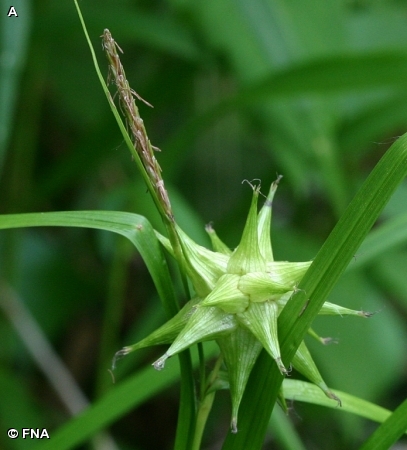
This sedge, which forms dense clumps, has flowering stems from 1-3 feet tall with dark green leaves 4-14 inches long and 1/2 inch wide. At the tip of the flowering stem is a single narrow male spike on a stalk of variable length (A). Immediately below are 1-2 unique and showy, rounded female spikes up to 1 3/4 inch in diameter. Spikes consist of 6-35 pale to dark green perigynia whose bases are densely wedged together with the tapered beak-like tips radiating out in all directions. Perigynia are relatively large measuring 1/2 to 7/8 inch long.
Lowland woods, swamps, stream margins. Rare in the prairie garden area east of the Wetland Learning Center at Fontenelle Forest. Not present at Neale Woods. Flowering occurs in May. The perigynia may persist throughout the summer.
This plant is native to states immediately to our south and east, but not to Fontenelle Forest. It most likely arrived in seed used to plant the garden area to the east and south of the Wetlands Learning Center. The handsome foliage and unique, showy spikes which persist into the fall and winter have prompted its use in shaded sites as an ornamental garden plant.
The unusual arrangement of the perigynia has prompted many creative names including Globe, Bur and Morningstar sedge. It is sometimes called Mace Sedge because of its resemblance to the medieval weapon of that name.
The content of NatureSearch is provided by dedicated volunteer Naturalists of Fontenelle Forest who strive to provide the most accurate information available. Contributors of the images retain their copyrights. The point of contact for this page is: Neal Ratzlaff.



